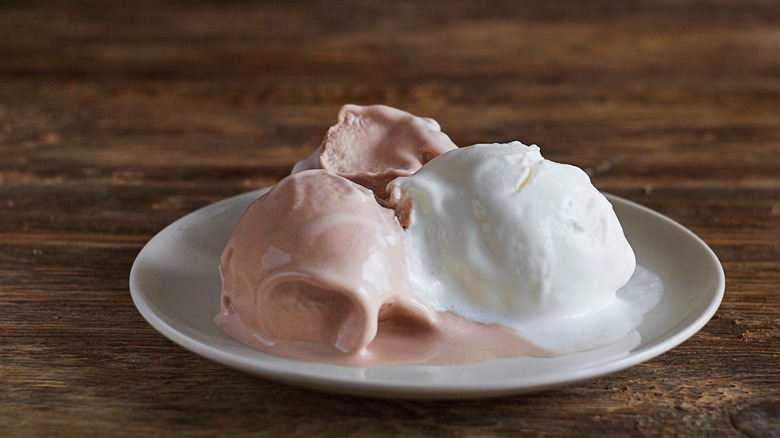The Plastic Bag Hack That Keeps Ice Cream Scoopable
Although we all want our ice cream to be frozen, its texture shouldn't be so hard that scooping it out of its carton becomes an impossible struggle. Interestingly, storing ice cream cartons in plastic bags — the ones that either zip or seal completely shut — is an easy hack that can help achieve this balance.
Similar to how a winter coat can help buffer against cold air, a plastic bag acts as an insulator in the freezer. The cold must penetrate the bag, the air within it, and then the carton itself before finally affecting the ice cream. The plastic bag layer helps keep the ice cream soft and easily scoopable.
What's more, plastic bags can also prevent freezer burn from affecting your ice cream. This extra sheet of protection between the ice cream and the freezer's environment reduces exposure to oxygen, thereby minimizing ice crystal growth. Consequently, the ice cream remains smooth and creamy, instead of becoming rock-hard and crunchy.
Store your ice cream properly to maintain the ideal texture
Storing your ice cream cartons in plastic bags may prevent them from becoming completely solid, but you may still encounter inevitable texture changes. Regardless of the container used, if you store ice cream in the freezer door or at the front of the freezer, it will still be exposed to temperature fluctuations every time the door is opened.
Instead, place your ice cream in the middle or at the back of the freezer, where the temperature remains more consistent. This practice also helps minimize thawing and refreezing, thereby preventing the formation of ice crystals commonly known as freezer burn. After all, the purpose of buying ice cream isn't to let it melt or freeze into a flavorless block of ice.
For best results, check the temperature settings of your freezer. Generally, freezers should be set at 0 degrees Fahrenheit, while ice cream is ideally stored at temperatures between -20 and -5 degrees Fahrenheit. Storing ice cream at the recommended freezer temperature may not be ideal for long-term storage, but it certainly facilitates easier scooping in the short term.
Additional ways to make ice cream easy to scoop
Whether you've forgotten to put your ice cream carton in a plastic bag, or simply prefer not to (no judgment here), there are still many ways to simplify scooping ice cream.
For example, dipping your spoon or ice cream scoop in hot water before digging into the ice cream can help. The warmth from the utensil gently melts the ice cream, making it easier to cut into and scoop, while the water helps prevent sticking. However, you might need to reheat the spoon between scoops, which can be cumbersome when serving ice cream to a large group.
As an alternative, you can thaw your ice cream proactively by placing it in the refrigerator for no more than 20 minutes before you plan to scoop it. While subjecting ice cream to fluctuating temperatures is not ideal for long-term storage, this method is handy when most, or all, of the ice cream will be consumed in one sitting and not returned to the freezer.



